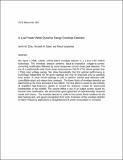| dc.contributor.author | Zhak, Serhii M. | |
| dc.contributor.author | Baker, Michael W. | |
| dc.contributor.author | Sarpeshkar, Rahul | |
| dc.date.accessioned | 2004-10-12T14:21:27Z | |
| dc.date.available | 2004-10-12T14:21:27Z | |
| dc.date.issued | 2004-10-12T14:21:27Z | |
| dc.identifier.uri | http://hdl.handle.net/1721.1/6743 | |
| dc.description | Author Information
Zhak: Department of Electrical Engineering and Computer Science, MIT, Cambridge,
MA 02139.
Baker: Department of Electrical Engineering and Computer Science, MIT, Cambridge,
MA 02139.
Sarpeshkar: Department of Electrical Engineering and Computer Science, MIT,
Cambridge, MA 02139. | en |
| dc.description.abstract | We report a 75dB, 2.8mW, 100Hz-10kHz envelope detector in a 1.5mm 2.8V CMOS
technology. The envelope detector performs input-dc-insensitive voltage-to-currentconverting
rectification followed by novel nanopower current-mode peak detection. The
use of a subthreshold wide- linear-range transconductor (WLR OTA) allows greater than
1.7Vpp input voltage swings. We show theoretically that this optimal performance is
technology-independent for the given topology and may be improved only by spending
more power. A novel circuit topology is used to perform 140nW peak detection with
controllable attack and release time constants. The lower limits of envelope detection are
determined by the more dominant of two effects: The first effect is caused by the inability
of amplified high-frequency signals to exceed the deadzone created by exponential
nonlinearities in the rectifier. The second effect is due to an output current caused by
thermal noise rectification. We demonstrate good agreement of experimentally measured
results with theory. The envelope detector is useful in low power bionic implants for the
deaf, hearing aids, and speech-recognition front ends. Extension of the envelope detector
to higher- frequency applications is straightforward if power consumption is inc | en |
| dc.description.sponsorship | Packard Foundation and an ONR Young Investigator Award. | en |
| dc.format.extent | 604455 bytes | |
| dc.format.mimetype | application/pdf | |
| dc.language.iso | en | |
| dc.relation.ispartofseries | Technical Report (Massachusetts Institute of Technology, Research Laboratory of Electronics);664 | |
| dc.subject | Bionic Ear, Cochlear Implant, | en |
| dc.subject | Peak Detector, | en |
| dc.subject | Ultra-Low Power, | en |
| dc.subject | Hearing Aids, | en |
| dc.subject | Envelope Detector, | en |
| dc.title | A Low Power Wide Dynamic Range Envelope Detector | en |
| dc.type | Technical Report | en |
